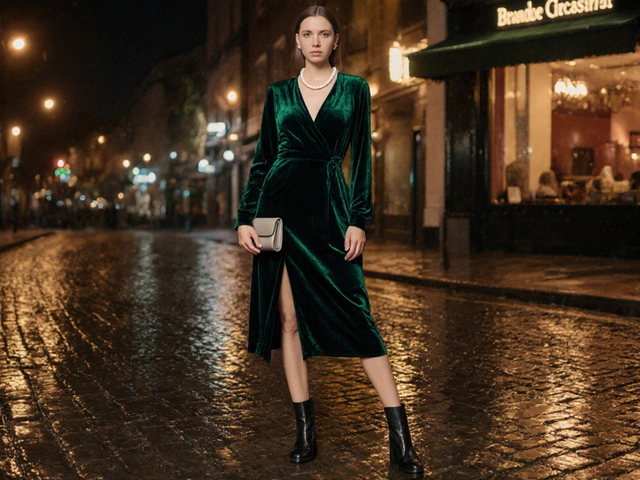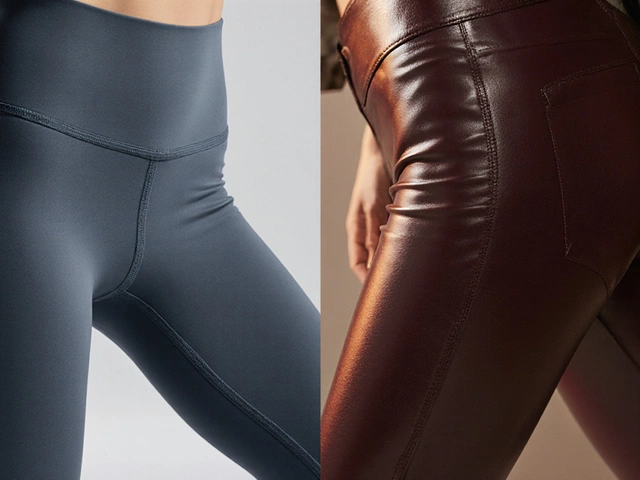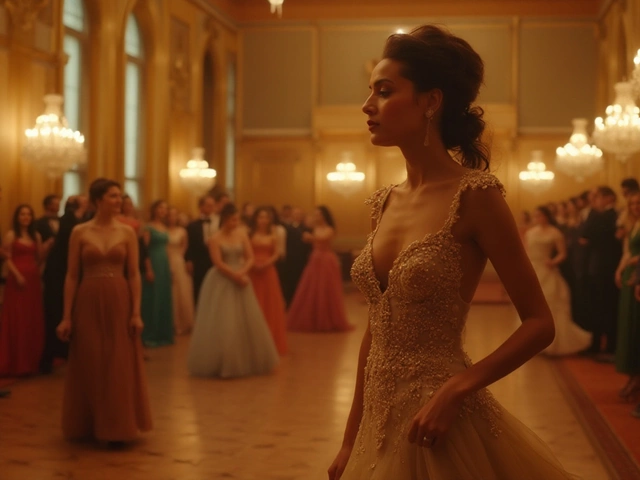Summer Clothing Colors: What to Wear for a Cool Look

- Cleo Fairchild
- 31 December 2024
- 0 Comments
As the sun climbs higher in the sky and the days grow longer, the right choice of clothing colors can not only enhance your style but also help you stay comfortable in the heat. Summer is a season that begs for playful, fresh, and lively hues.
The right colors don't just make you look good; they can also make a real difference in how you feel in the sweltering sun. Knowing which shades to reach for when dressing for those sun-drenched days can keep you feeling cool and fashion-forward.
- The Science of Color and Heat
- Classic Summer Shades
- Brights and Patterns
- Matching Colors with Skin Tone
- Accessorizing Your Summer Look
The Science of Color and Heat
Understanding the interplay between colors and heat is key to dressing smartly during the summer months. The color of your clothing can significantly affect how much heat it absorbs from sunlight. This stems from basic physics; when light hits an object, it can be reflected, absorbed, or transmitted. In the context of clothing, dark colors absorb more light, which is converted to heat, hence making the wearer warmer. Conversely, light colors reflect a large portion of the sunlight and therefore, absorb less heat, keeping the body cooler. This is why, intuitively, people prefer wearing whites, pastels, and light shades during the hot season.
Consider how white clothes are often seen as a practical choice for summer. White reflects almost all wavelengths of light and absorbs very little, resulting in a cooling effect. On the other hand, black or dark colors absorb more light and can make even a slight temperature appear stifling. An interesting fact is that deserts natives, despite the scorching heat, sometimes wear black. This might seem counterintuitive, but in strong wind conditions, dark colors can facilitate heat dissipation from the fabric to the air, thus cooling the skin underneath.
Another fascinating aspect concerns textured fabrics. Textured clothing allows more air circulation, which can help in thermal regulation alongside choosing the right color. A summer outfit made from loosely knitted white or light-colored fabric can not only look chic but also feel more comfortable by promoting airflow. Materials like cotton and linen, naturally light-colored, also enhance this cooling effect. According to a study published by the Journal of Applied Sciences & Engineering, white linen can reflect up to 70% of the sun's rays, exemplifying its efficiency in warm climates.
"It’s not just the color, but how a material interacts with light that defines its ability to heat or cool," says Dr. Emily Watson, a textile scientist from Fashion Institute of Technology. Her work emphasizes a more nuanced understanding of textile behaviors beyond surface color.
Interestingly, the psychological effects of colors also play a role in our color choices. Light colors are often associated with feelings of coolness and calmness, while bright shades might energize one's mood on another level. However, balance is key. Incorporating bright bursts of color in accessories can also make a summer wardrobe pop without compromising comfort. By strategically mixing hues and fabric types, one can achieve both function and fashion in building a summer outfit.
Classic Summer Shades
When you think of summer and those long, sun-drenched days, certain colors immediately spring to mind. The traditional palette for summer outfits often teems with light and breezy hues that evoke the feeling of coolness even when the temperature soars. White, for instance, is a perennial favorite. It is not only a symbol of sophistication and simplicity but also a practical choice. White reflects the sun’s rays, helping to keep your body temperature down while exuding a fresh and airy vibe. It is a blank canvas that allows other colors to pop, making it versatile in any wardrobe.
Pale blues and greens are also quintessential colors representing summer’s tranquil side. These shades mimic the vast, open sky or a serene sea and have a calming effect, something much needed amidst the humidity and heat. Baby blue or mint green dresses or shirts can imbue your appearance with a dreamy, laid-back aesthetic characteristic of the beach life. Interestingly, the psychology of these colors is worth mentioning—blue often conveys trust and stability, while green is seen as restorative and harmonious.
A well-dressed summer is not just about trends but about choosing colors that feel right for the climate and spirit. "In fashion, fun and light are synonymous," noted reputable designer Giorgio Armani, highlighting how the right shades can complement our environment and mood.
Another classic shade that never goes out of style is yellow, reminiscent of sunshine and cheer. Often associated with happiness and positivity, wearing yellow can lift your mood and those around you. From buttercup to marigold, pairing yellow with neutrals or denim adds a chic and vibrant touch to your summer wardrobe. Pastels, on the other hand, offer a softer, more subtle take for those who shy away from bold colors. They can range from pale pinks to light lavenders, evoking gentle, blooming florals typically seen in summer gardens.
These classic shades hold a timeless appeal, reaffirming their place in summer fashion year after year. They act as a foundation for integrating other trends and hues, allowing for creativity and personal expression. So when selecting colors, remember that lightness and mood should guide your decisions, ensuring comfort and style on every sunny occasion.

Brights and Patterns
When summer arrives, many of us feel an instinctive pull toward vibrant colors that match the energy of the season. This is the time to let your fashion choices reflect the radiant hues of the sun, sea, and landscape. Wearing bright colors during this warm season not only elevates your mood but also catches the eye. Bold colors like orange, electric blue, hot pink, and sunshine yellow are known to bring cheerfulness and warmth. These tones have a psychological impact, often making wearers and those around them feel more energetic and positive.
Patterns, on the other hand, can add a dynamic twist to your summer outfits, making them even more interesting. From floral prints to geometric designs and tropical motifs, patterns can evoke various aspects of summer, from garden blooms to beach holidays. Interestingly, patterns like stripes in light and dark contrasts not only create a visual interest but can also be quite flattering by elongating or accentuating parts of the body. Pairing patterned pieces with solid, classic summer shades offers balance, allowing one’s fashion choices to speak vibrantly without overwhelming.
Many fashion experts agree that brights and patterns are essential in a summer wardrobe. Carrie Donovan, a former fashion editor, once remarked, "Color is the most overwhelming presence in our lives, and it's crucial to match it not only to your personality but to the season."
"In the season of light, do not shy away from exploring a kaleidoscope of hues,"she suggested. This philosophy captures the essence of summer dressing – a playful time to experiment and step outside the norms.
For those uncertain about committing fully to bright colors or bold patterns, start small. Adding splashes of color through accessories like scarves or shoes, or investing in a single, statement piece can make all the difference. The beauty of fashion tips in the summer is that there's ample room for play and personal expression through color choices. Remember, the key is to feel confident and comfortable in what you wear, so it's okay to build up gradually to bolder pieces as you become more comfortable with stepping out in brighter hues.
Matching Colors with Skin Tone
Choosing the perfect color for your summer outfits isn't just about following the trend; it's about enhancing your natural glow and highlighting your best features. Each skin tone has a spectrum of colors that can either complement or detract from its unique characteristics. Understanding the science behind these tones and the way they interact with different colors can elevate your fashion tips to an entirely new level.
The concept of skin tone extends beyond the basic 'light', 'medium,' and 'dark.' It includes undertones, which are the subtle hue beneath your skin color. These can be categorized into three main types: warm, cool, and neutral. Warm undertones often have a yellow, golden, or peachy hue, while cool undertones are usually characterized by pink, red, or blue shades. Neutral undertones fall somewhere in between or may share characteristics of both.
For those with warm undertones, earthy tones such as mustard yellow, amber, burnt orange, or olive green can bring out the gold radiance in your skin. These colors align with nature and warmth, reflecting a heat that feels both inviting and invigorating. Cool undertones, on the other hand, thrive with jewel tones. Lean towards emerald, sapphire blue, or cool purples to enhance the rosy flush of your skin. Neutrals have the fun advantage of playing with both ends of the spectrum, though they often shine brightest with colors like soft pinks and dusty pastels.
"The secret to looking great in color is not just about following fashion trends; it's about knowing your skin tone and choosing shades that complement it," noted fashion expert Stacy London.
Beyond just the coloring, fabric plays a critical role in how these hues appear. Natural, breathable fabrics such as cotton and linen can complement summer wardrobe colors without causing you to overheat. Moreover, remember that different lighting can change how colors appear. Always test your outfit under natural light if possible, as store lighting might not give you the true picture.
Lastly, here’s a fun exercise. Stand in front of a mirror and drape different colored fabrics over your shoulders without makeup on. Notice how each color touches your face. Which colors make your eyes pop or your skin look healthy? Make a color palette based on this simple at-home test to refine your summer outfits, ensuring that each piece accentuates your natural beauty.

Accessorizing Your Summer Look
Summer is the perfect time to experiment with fashion tips and accessories to refine your seasonal outfits. The art of accessorizing isn't merely about adding trinkets to your ensemble; it's about highlighting your personal style while keeping functionality in mind as the temperature rises. Consider the practical and aesthetic appeal of accessories that match summer outfits, blending a harmonious balance between chic and comfort.
Lightweight scarves can add a touch of elegance to your ensemble while providing mild sun protection. A brightly colored scarf can double as a headband or a stylish waist sash, demonstrating the versatile nature of summer accessories. Similarly, hats not only elevate your look but also offer shade from the sun. Wide-brimmed hats or fun fedoras can tie together a casual beach outfit and provide necessary protection against UV rays. Pairing a hat with sunglasses creates a classic look that works for both fashion and function.
The Fashion Institute of Technology states, "Accessories are transformative, much like clothing, they can change the look and feel of an outfit in an instant."Adopting accessories with lightweight materials is essential in summer. Jewelry can be problematic due to heat retention, so opt for pieces made from materials like wood, shell, or fabric that complement your clothing colors. Statement necklaces or earrings can add splashes of color without overwhelming the simplicity of summer styling.
Strengthen your style with summer bags, opting for bold hues or crisp whites that reflect the season’s vibe. Straw and woven bags offer texture and are an excellent choice for beach days. When it comes to shoes, sandals made with airy designs provide comfort and style. Explore vivid or pastel color palettes to match or contrast with your outfit, ensuring your footwear becomes a part of your seasonal story.
Summertime is also a great opportunity to experiment with layering accessories. Light cardigans, shawls, or even cotton wraps can add depth to your look during morning or evening outings when the temperature might drop slightly. These layers not only add sophistication but can also serve as an additional canvas for expressing your fashion sensibilities. Keep in mind that finding the right balance between comfort and style is key, never sacrificing one for the other without good reason.
The art of accessorizing in summer is as much about expression as it is about embracing practicality. Perfecting your summer wardrobe with thoughtfully chosen accessories can greatly enhance your personal style. Whether you're going for a walk on the beach or attending a summer soirée, remember that your accessories are not just embellishments but integral parts of your fashion expression. They provide the finishing touch to summer outfits, making the season as stylish as it is enjoyable.


